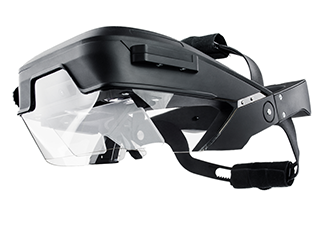Augmented Reality in the working world
Glass@Service project successfully completed
Augmented Reality (AR) has arrived in the working world: Over the past three years, a consortium of six companies and institutions led by Siemens has conducted research on AR in industry. The aim of the project Glass@Service was to use intelligent data glasses as personalized information systems by combining them with novel interaction options such as eye and gesture control and innovative IT services. The first practical tests in real production and logistics processes have now been successfully finished.
Digitalization is increasingly penetrating the manufacturing process. In some areas, however, especially when retooling machines and picking orders, employees often still work with printed lists, print labels on stock for marking material and, in the end, laboriously record all data in the merchandise management system. This is why AR has been investigated for several years to what extent it could be used in these areas. Now, the necessary technological components such as microdisplays, controller electronics, 3D cameras and sensors are so mature that they can be combined into a novel human-machine interaction and integrated into the IT landscape of a factory. "Siemens wants to help shape this change in the working world right from the start," explains Frank-Peter Schiefelbein from the consortium leader Siemens.
In the context of the public funded Glass@Service project, scientists of Fraunhofer Institute for Organic Electronics, Electron Beam and Plasma Technology FEP have developed a new "720p microdisplay" that features high frame rates and high contrast ratios based on OLED-on-silicon technology. In addition to a resolution of 1280 x 720 pixels with a screen diagonal of 0.64 inches, it also offers low power consumption and thus meets an important criterion for AR applications. The practical tests took place at the Siemens electronics plant in Amberg and at the manufacturing site in Fuerth/Germany. Depending on the field of application, the software of the AR system has to be tailored specially to the requirements. In logistics, the main focus is on the wearables to help employees find their way around the warehouse and to identify, to mark and to process the products online in the merchandise management system without errors. During the retooling or maintenance of machines, the data glasses can provide valuable services by showing every work step on the display and supporting the employee in the operation of machines. So called eyetracking cameras are used to record eye movements. The system can be interacted with by consciously controlling the viewing direction and, for example, a data sheet can be scrolled.
Besides Siemens, the Federal Institute for Occupational Safety and Health (BAuA), the Fraunhofer FEP and the companies DIOPTIC GmbH, Ubimax GmbH and UVEX Arbeitsschutz GmbH were involved in the research project. Glass@Service was funded by the Federal Ministry of Economics and Energy.
The AR application possibilities examined in the Siemens plants will be pursued further in internal projects and are to be put into productive operation in the midterm. Further research projects are to follow in order to investigate further areas of application for augmented reality in production and service on the basis of previous experience.
 Fraunhofer Institute for Electron Beam
Fraunhofer Institute for Electron Beam